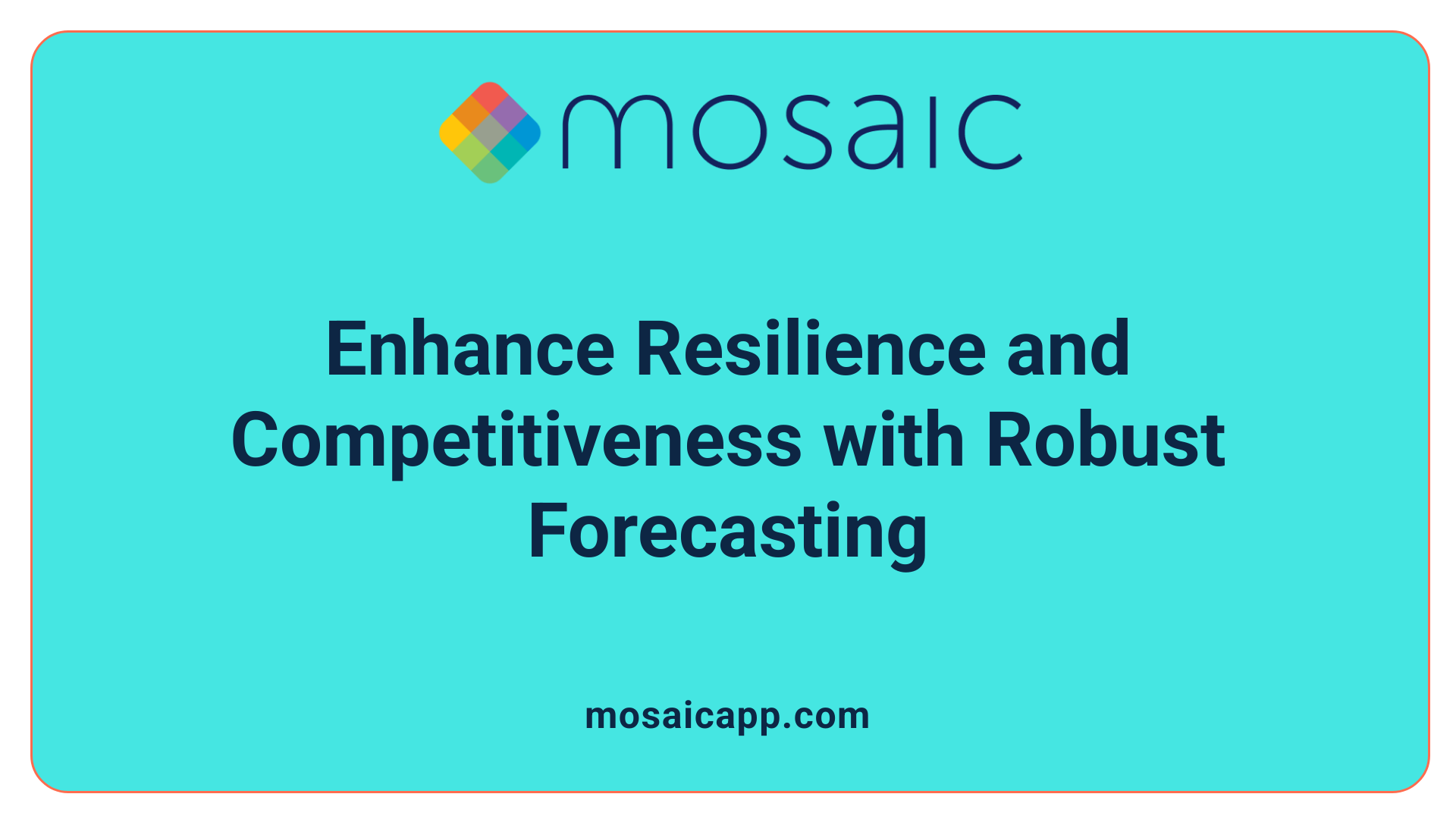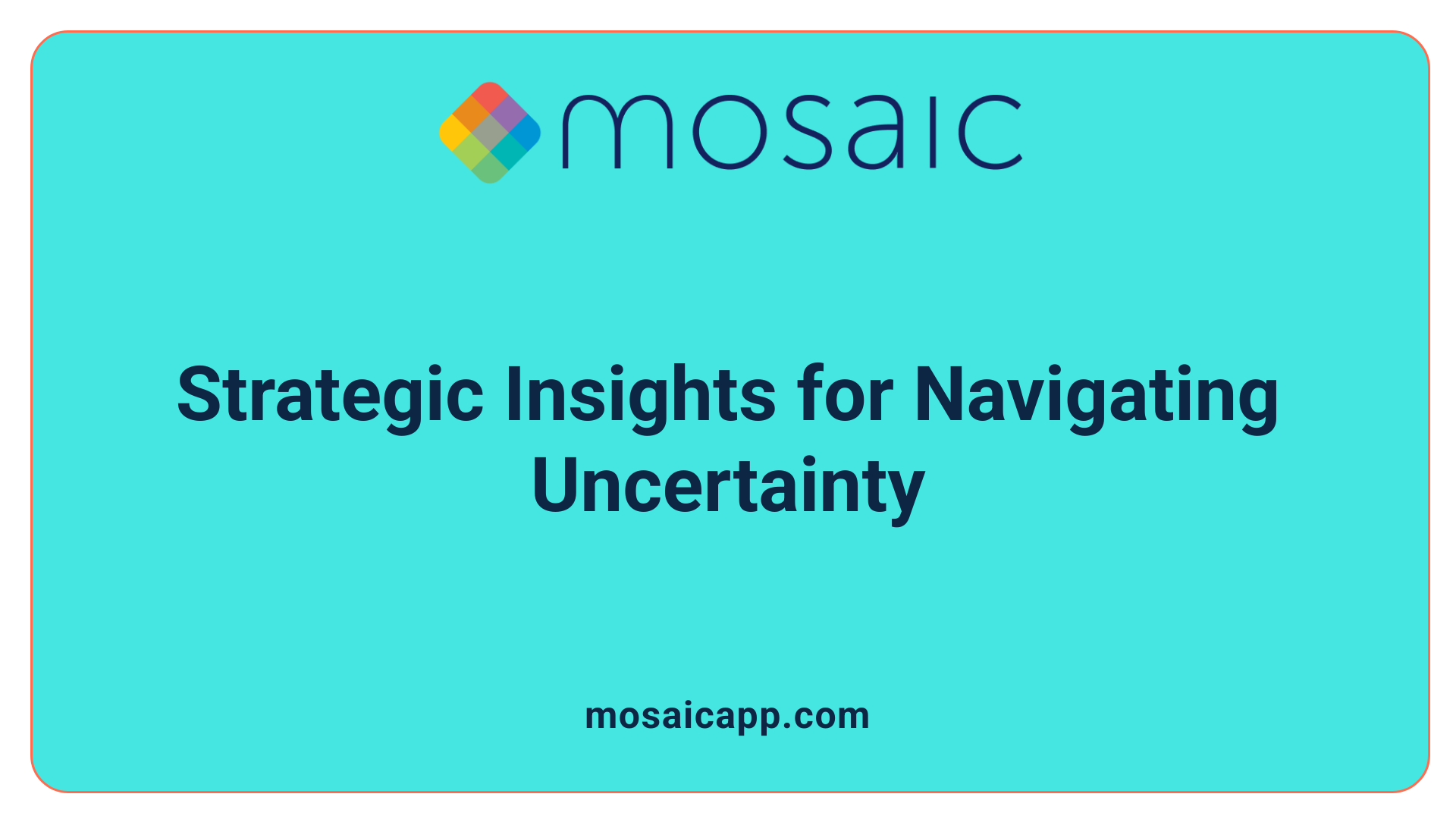Navigating Uncertain Economic Waters: Strategies for Service Firms
In today's unpredictable economic landscape, service firms face unprecedented challenges that threaten profitability and operational stability. Implementing robust forecasting techniques and adaptive financial planning is essential for resilience. This article explores effective strategies, advanced tools, and industry-specific solutions that enable service organizations to forecast with confidence, maintain financial health, and capitalize on opportunities amidst volatility.
The Critical Role of Accurate Forecasting in Service Industries

How important is forecasting for investor confidence, strategic planning, and risk assessment?
Forecasting plays a crucial role in strengthening investor confidence by providing transparent, data-backed projections about a company's future performance. When organizations accurately predict revenue, expenses, and cash flows, they demonstrate stability and reliability, reassuring investors and stakeholders.
For strategic planning, forecasting offers a roadmap for setting achievable goals, allocating resources efficiently, and defining growth pathways. It helps decision-makers evaluate potential market conditions and prepare adaptable strategies.
In terms of risk assessment, accurate forecasts enable firms to identify vulnerabilities, anticipate downturns, and develop mitigation measures. By modeling different scenarios, organizations can better understand potential challenges and proactively address them.
Overall, robust forecasting ensures organizations remain resilient and agile amidst economic fluctuations, fostering trust and supporting long-term success.
How does forecast accuracy impact share price and organizational value?
Research indicates that organizations with higher forecast accuracy tend to see more significant increases in share prices. For instance, data shows that firms achieving better forecasting results experience a 46% share price rise over three years, compared to 34% for less accurate counterparts.
Accurate forecasts contribute to better investor perceptions, reducing uncertainty and volatility in the stock market. Investors place higher confidence in companies that provide reliable projections, which often reflects positively on organizational valuation.
Furthermore, forecast accuracy influences strategic investments, creditworthiness, and access to capital, all of which enhance overall organizational value. Conversely, forecast inaccuracies can lead to misallocated resources, reduced investor trust, and lower market capitalization.
What challenges hinder achieving high forecast accuracy?
Achieving precise forecasts remains challenging due to several factors:
- Data issues: Inaccurate, incomplete, or outdated data undermine forecast reliability.
- Market volatility: Unpredictable economic, political, or technological changes can deviate actual outcomes from projections.
- External influences: External sources such as regulatory shifts or natural disasters introduce unforeseen dynamics.
- Cognitive biases: Overconfidence, anchoring, or groupthink can skew forecasts.
- Technological limitations: Relying solely on spreadsheets or traditional methods without leveraging advanced analytics hampers accuracy.
Overcoming these barriers requires organizations to improve data quality, adopt innovative forecasting tools, and foster a culture that values continuous learning and adaptability.
How can principles of cash flow management help maintain financial stability in volatile markets?
Principles of cash flow management are vital for maintaining stability during unpredictable times. Accurate forecasting helps determine the timing and amounts of cash inflows and outflows.
Effective practices include building and monitoring an emergency fund, ensuring optimal working capital, and adjusting operational activities based on real-time data.
Linking capital strategies with long-term business goals allows companies to set realistic cash flow targets and prepare for fluctuations.
Employing technology like real-time financial systems and predictive analytics enhances visibility and enables swift adjustments to changing conditions. Moreover, strategic measures such as diversifying investments, optimizing receivables and payables, and controlling costs help preserve liquidity.
By applying these principles, organizations can navigate market downturns more resiliently, seize emerging opportunities, and preserve operational continuity.
What strategies and best practices improve forecasting accuracy in service firms during uncertain economic conditions?
To bolster forecast accuracy amidst economic turbulence, service firms should leverage advanced technology, including AI and predictive analytics, to automate data collection and analysis, reducing manual errors.
Developing multiple scenario plans, including best-case, worst-case, and most-likely outcomes, helps organizations prepare for diverse potential futures.
Fostering cross-department collaboration ensures comprehensive data sharing and alignment of assumptions across sales, finance, operations, and external partners.
Regularly evaluating forecast discrepancies against actual results allows refinement of models and assumptions for future iterations.
Employing external intelligence such as market scans and environmental analyses (e.g., PESTEL) enables early anticipation of external shocks.
These practices, combined with the use of integrated forecasting platforms, enhance resilience and decision-making accuracy during uncertain periods.
How can service organizations build confidence in their forecasting and planning processes?
Building confidence involves deploying reliable forecasting tools like AI and advanced analytics to provide real-time, accurate data.
Strong governance, including data quality standards and transparent methodologies, underpins forecast credibility.
Collaborative culture, where operational managers actively participate in planning, increases buy-in and contextual understanding.
Consistent process discipline, including regular updates, performance reviews, and sensitivity analyses, helps identify and correct errors proactively.
Leadership commitment and clear communication about forecasts' assumptions and limitations further bolster stakeholder trust.
Ultimately, transparency, technological support, and organizational discipline support well-founded confidence in forecasts.
What methods support effective financial outcome forecasting, accounting for risk and resilience?
Effective forecasting employs various quantitative methods, such as linear regression, scenario analysis, and stress testing, to anticipate potential outcomes.
Incorporating risk mitigation strategies like diversification, contingency reserves, and scenario planning enhances resilience.
Employing advanced analytics, including machine learning and AI, allows for real-time data processing and dynamic prediction updates.
Integrating risk assessments related to credit, liquidity, and operations directly into forecasts ensures comprehensive planning.
Regularly reviewing actual results against projections uncovers areas of uncertainty, informing adjustments and improving future accuracy.
Combining these approaches enables organizations to prepare for uncertainties, respond swiftly to shocks, and maintain financial stability.
The Power of Advanced Forecasting Techniques and Technology Adoption

How are AI, machine learning, and predictive analytics transforming forecasting?
The integration of artificial intelligence (AI), machine learning (ML), and predictive analytics is revolutionizing financial forecasting across industries. These advanced technologies analyze vast amounts of real-time data to identify patterns and trends that traditional methods might overlook.
AI-driven tools can automatically update forecasts as new data becomes available, reducing manual effort and increasing accuracy. Machine learning models improve over time by learning from historical data, allowing firms to refine their predictions continually.
Predictive analytics provides insights into future scenarios, helping organizations anticipate market shifts, customer behavior, and economic changes. This proactive approach enhances resilience and strategic agility.
How do causal, statistical, and econometric models work together in modern forecasting?
Modern forecasting often involves combining multiple models to improve reliability. Causal models establish relationships between variables—for example, how interest rates influence consumer spending.
Statistical methods like time series analysis, including moving averages and exponential smoothing, analyze historical data to project future outcomes.
Econometric models integrate economic indicators with market data, allowing firms to evaluate how macroeconomic factors impact their specific industry or product.
By blending these approaches, organizations develop comprehensive forecasts that consider various influencing factors, making predictions more robust and adaptable.
What’s causing the shift from manual spreadsheets to automated, real-time tools?
Traditionally, many companies relied on spreadsheets for forecasting, which often led to errors, outdated information, and limited scalability.
The advent of cloud computing and integrated software platforms has enabled automated, real-time forecasting. Tools like enterprise resource planning (ERP) systems and special purpose analytics platforms continuously gather and analyze data.
Automation reduces manual input, speeds up updates, and provides stakeholders with up-to-the-minute insights. This transition supports more frequent forecasting cycles—moving from annual or quarterly updates to near real-time decision-making.
Organizations that adopt these technologies benefit from increased forecast accuracy, better risk management, and enhanced responsiveness to market dynamics.
How do these techniques address industry-specific challenges, especially in service firms?
Service firms experience unique challenges, including demand fluctuations, customized client needs, and intense competition. Advanced forecasting techniques provide the agility necessary to manage these complexities.
Time series analysis helps track seasonal demand patterns, while causal models assess the impact of external factors such as economic conditions or regulatory changes.
Qualitative methods like Delphi panels and market research are useful during product development stages or when data is scarce.
Leveraging real-time data through predictive analytics allows these firms to respond swiftly to demand changes, optimize resource allocation, and fine-tune revenue estimates.
By combining multiple methods within integrated platforms—such as ERP and professional service automation (PSA) systems—service organizations can better understand demand patterns, forecast profitability, and strategize effectively.
How should forecasting techniques be tailored to different stages of a service product's life cycle?
Effective forecasting depends heavily on the product’s development stage. During the initial development and testing phases, qualitative methods like expert panels, market surveys, and scenario planning are vital for estimating potential demand and market acceptance.
In the rapid growth phase, firms should focus on tracking actual sales data, customer feedback, and employing time series analysis to project future growth. Simulating demand pipelines and inventory needs supports capacity planning.
As the service matures into a steady state, time series models such as exponential smoothing and causal models become more applicable for long-term forecasting. Disaggregated market models and demand simulations help manage the complex dynamics in mature markets.
Throughout all phases, integrating predictive analytics and continuously updating models with fresh data is essential to maintain accuracy and responsiveness.
What role does technology play in improving forecast reliability?
Technology significantly enhances forecast reliability through automation, data integration, and sophisticated analytical capabilities. Advanced software platforms facilitate the collection and analysis of real-time data, enabling organizations to update forecasts more frequently and accurately.
Machine learning algorithms improve prediction precision by adapting to new patterns without manual intervention.
Scenario planning and stress testing tools allow firms to evaluate potential future shocks and prepare contingency plans.
Furthermore, cloud-based solutions enable collaboration among various departments, ensuring consistent forecast updates aligned with overall strategic goals.
The combined effect of these technological advancements leads to more reliable forecasts, improved decision-making, and a greater ability to navigate market uncertainties.
Building Organizational Resilience and Competitiveness through Forecasting

How can principles of cash flow management help maintain financial stability in volatile markets?
Effective cash flow management is vital for maintaining financial stability during uncertain economic conditions. It starts with accurate forecasting, which enables organizations to anticipate cash inflows and outflows, ensuring sufficient liquidity to meet operational needs. Strategic working capital optimization, such as managing receivables and payables efficiently, helps stabilize cash levels and reduce unnecessary costs.
Linking long-term capital strategies with overall business goals allows companies to set realistic cash targets. Using technology—like real-time financial systems, automation, and predictive analytics—improves visibility and helps detect potential shortfalls early. Building contingency funds acts as a buffer against unexpected market downturns, protecting liquidity.
Diversification of investments spreads risk, reducing dependence on a single source of income. Proactive management of collection processes and extending supplier payment terms can further smooth cash flows.
By applying these principles, organizations can adapt swiftly to market shifts, preserve operational resilience, and capitalize on emerging opportunities despite volatility.
How can service organizations integrate scenario planning and sensitivity analysis into their forecasting processes?
Service organizations face unique challenges in forecasting due to fluctuating project timings, client payment cycles, and resource utilization. To address these, they can incorporate scenario planning and sensitivity analysis into their regular methods.
Firstly, define key variables such as customer demand, payment delays, staffing costs, and project pipeline volume. Develop multiple scenarios—best case, worst case, and most likely—that reflect different assumptions about these drivers.
Regularly update these models with fresh data to keep scenarios relevant. Cross-department collaboration ensures diverse insights and validation of assumptions, improving model accuracy.
Visualization tools can help communicate potential impacts and risks to stakeholders clearly. Incorporating the results of scenario and sensitivity analyses into rolling forecasts allows organizations to react proactively to changing conditions.
This approach enables service firms to identify vulnerabilities, allocate resources effectively, and implement contingency plans swiftly. It enhances their strategic agility and resilience, helping them navigate unpredictability with confidence.
| Aspect | Approach | Benefits | How it supports resilience |
|---|---|---|---|
| Cash flow stability | Accurate forecasting, working capital management | Maintains liquidity, reduces unexpected shortages | Preserves operational continuity during market shocks |
| Scenario Analysis | Defining key drivers, constructing multiple scenarios | Anticipates risks, uncovers vulnerabilities | Enables preemptive adjustments in strategy |
| Technology Use | Real-time systems, predictive analytics | Quick decision-making, error reduction | Facilitates rapid responses to market changes |
| Diversification | Revenue streams, geographic expansion | Reduces dependence on single markets | Buffers against localized downturns |
Additional Insights
Forecasting methods have evolved to include qualitative assessments, quantitative analysis, and integrated models. Techniques such as time series analysis, causal models, and scenario planning are tailored to specific industry and organizational needs.
In volatile markets, adopting a layered set of tools offers better insights. Rolling forecasts, with updates at regular intervals, enhance agility and responsiveness.
For service organizations, unique factors like project backlog, client payments, and resource allocation require customized approaches. Combining multiple methods improves accuracy.
Technology plays a crucial role in modern forecasting. AI and machine learning facilitate sophisticated predictive models that adjust dynamically to market data, allowing organizations to anticipate shifts before they occur.
In summary, integrating scenario planning and sensitivity analysis into forecasting not only prepares organizations for uncertainty but also enables strategic flexibility, fostering resilience and competitive advantage amidst volatility.
Transforming Financial Forecasting: From Spreadsheets to Smart Systems

Why is reliance on spreadsheets insufficient for forecasting during uncertain times?
Traditional spreadsheets have long been a staple in financial management, but in today's volatile environment, they often fall short. Manual spreadsheets are susceptible to errors—small mistakes can significantly distort forecasts and lead to poor decision-making. They offer limited collaboration features, making it difficult for teams across different locations to work simultaneously or share insights effectively.
Moreover, spreadsheets lack real-time data integration. They rely on static inputs that can become outdated quickly, especially when market conditions shift unexpectedly. This delays the response time, hampering the organization's ability to adapt swiftly.
Automated, cloud-based forecasting tools address these issues by providing a dynamic and centralized data environment. These platforms analyze up-to-date information continuously, allowing businesses to run multiple scenario tests rapidly. This agility is crucial in uncertain times, as it helps organizations maintain accuracy and responsiveness.
Advanced AI and machine learning algorithms further revolutionize forecasting. They process vast volumes of data—far beyond human capacity—identifying complex patterns and correlations that might otherwise go unnoticed. These systems can update predictions automatically, eliminating human bias and enhancing precision.
Transitioning from traditional spreadsheets to these sophisticated tools empowers service firms to react swiftly to market shifts, improve planning accuracy, and sustain profitability amid unpredictability.
What are the key components of effective rolling forecasts, and how do they support managerial decision-making?
Effective rolling forecasts comprise several critical elements. First, they require a regular update cycle—monthly, quarterly, or even more frequently—ensuring that projections remain aligned with the current business state.
Second, comprehensive data collection from both internal systems and external market sources is essential. This wide data intake enables more accurate and informed forecasts.
Third, scenario and sensitivity analysis is vital to explore various potential futures. By simulating different economic, operational, or market conditions, organizations can understand possible risks and opportunities.
These components are integrated into financial models that are adaptable to changing operational parameters and external influences. Technology-enabled platforms facilitate seamless updates, enable collaborative input, and visualize forecast data clearly.
Managing these updates effectively supports decision-making by providing leadership with timely insights into cash flow, revenue, and expenses. Armed with real-time data, managers can proactively allocate resources, adjust strategies, and mitigate risks.
Rolling forecasts enhance organizational agility by aligning financial plans with current performance and market trends. This ongoing process allows businesses to pivot quickly, make informed strategic decisions, and maintain resilience, ultimately sustaining competitive advantage and profitability.
Implementing a Culture of Forecasting Excellence and Organizational Buy-In

What methods can be used for effective financial outcome forecasting, including risk mitigation and resilience strategies?
Effective financial outcome forecasting combines various methods suited to the complexity of the business and the quality of available data. Quantitative techniques such as linear regression, moving averages, and scenario analysis help in predicting future revenue, expenses, and cash flows. These methods analyze historical data patterns and incorporate targeted assumptions.
Stress testing and probabilistic modeling are vital for risk mitigation, allowing organizations to evaluate how different shocks or adverse conditions could impact financial health. Scenario planning enhances resilience by preparing the organization for multiple possible futures, including best-case and worst-case situations.
Leveraging advanced tools like machine learning and artificial intelligence enables real-time data analysis, improving forecast accuracy and responsiveness. Integrating risk assessments related to credit, liquidity, operational disruptions, and market volatility ensures forecasts are comprehensive. These strategies support proactive decision-making and help organizations adapt swiftly to uncertain conditions.
Summary and Strategic Takeaways for Service Firms in Uncertain Times

How should budgeting and financial planning be adapted for professional service providers during uncertain times?
In volatile economic conditions, professional service firms must adopt flexible and responsive budgeting methods. Instead of rigid annual budgets, they should implement rolling forecasts that are regularly updated—monthly or quarterly—based on the latest market data. Incorporating scenario planning allows these organizations to prepare for a range of possible futures, from best-case to worst-case outcomes. Prioritizing controllable costs and streamlining operations help maintain financial health.
Building or maintaining an emergency fund provides a buffer against unforeseen disruptions like supply chain issues or inflation spikes. Effective communication with stakeholders such as lenders and utility providers ensures organizational agility. Leveraging technology for real-time data analysis and forecasts enhances decision-making. Cross-department collaboration, alongside professional financial advice, bolsters resilience, enabling firms to adapt swiftly to changing conditions.
What are the benefits of using rolling forecasts to manage financial uncertainty in service firms?
Rolling forecasts are invaluable tools for managing uncertainty because they enable ongoing adjustments based on current data and market developments. This continuous updating process enhances forecast accuracy and allows organizations to respond quickly to emerging risks or opportunities.
The flexible nature of rolling forecasts supports better resource allocation and strategic planning, especially in unpredictable environments. They foster alignment across departments and ensure that decision-makers operate with the most current financial insights. Additionally, regular review cycles promote proactive risk management, helping firms avoid cash shortages and optimize investments.
Overall, adopting this approach leads to greater strategic agility, improved financial stability, and a more resilient organization during turbulent times.
How can principles of cash flow management help maintain financial stability in volatile markets?
Effective cash flow management is fundamental to maintaining stability amid market volatility. Accurate forecasting of cash inflows and outflows helps organizations identify potential shortfalls early. Techniques such as optimizing receivables through automation and early payment discounts, and extending payment terms with suppliers, can enhance liquidity.
Building contingency funds and diversifying revenue streams serve as buffers against market shocks. Leveraging real-time financial systems and analytics enhances visibility, enabling swift corrective actions. Aligning capital strategies with business goals ensures that liquidity is preserved for core operations and growth opportunities.
Good cash flow practices, including scenario analysis and stress testing, prepare organizations to withstand unexpected downturns and capitalize on emerging opportunities, securing long-term financial resilience.
How can service organizations enhance confidence in their financial planning and forecasting processes?
Confidence is strengthened when organizations employ advanced technological tools such as predictive analytics, artificial intelligence, and integrated forecasting platforms. These tools improve forecast accuracy by integrating historical data, market trends, and scenario analysis.
Implementing strict data governance and fostering collaboration across departments—including operational managers—ensure that forecasts are comprehensive and grounded in real-world insights. Regular updates and performance reviews, comparing actual results against projections, help identify errors early and refine models.
Embedding a culture of disciplined forecasting, supported by leadership commitment and continuous training, further enhances reliability. When forecasts are transparent, data-driven, and adaptable, stakeholders develop greater trust in financial planning processes.
What methods can be used for effective financial outcome forecasting, including risk mitigation and resilience strategies?
Effective forecasting combines quantitative and qualitative methods tailored to business complexity. Quantitative techniques such as linear regression, moving averages, and stress testing provide data-driven predictions and variability assessments.
Qualitative methods, including scenario analysis, expert judgment, and sensitivity analysis, add depth and context, especially when data is limited or uncertain. Incorporating risk mitigation strategies like diversification, contingency reserves, and scenario planning enhances forecast robustness.
Emerging technologies—including machine learning and artificial intelligence—analyze large datasets in real-time, continuously refining predictions. Embedding risk assessments and resilience planning within financial models enables organizations to prepare for geopolitical shocks, technological disruptions, and market fluctuations.
This integrated approach not only improves forecast reliability but also reinforces organizational resilience, ensuring long-term sustainability amid uncertainty.
Embracing the Future: The Evolution of Financial Forecasting

What will future forecasting involve in terms of systems and models?
The landscape of financial forecasting is rapidly evolving, propelled by technological advances that promise more precise and adaptable predictions. Future forecasting will increasingly involve sophisticated computer-based, integrated systems. These systems will synergize various modeling approaches, including statistical techniques, causal analysis, and econometric models.
Moreover, the integration of consumer simulation models will provide deeper insights into behavioral and environmental factors affecting financial outcomes. These predictive systems will leverage artificial intelligence (AI) and machine learning (ML) algorithms to analyze massive datasets swiftly, identify complex patterns, and generate dynamic forecasts that adapt to real-time data inputs.
The rise of Internet of Things (IoT) data streams, along with advanced analytics, will allow organizations to respond promptly to market shifts and emerging trends. This holistic approach will incorporate behavioral insights, environmental impacts, and macroeconomic variables to create comprehensive predictive scenarios. As a result, service firms will be equipped to manage uncertainties proactively and capitalize on new opportunities with greater confidence.
In short, the future of finance forecasting is set to be characterized by high automation, enhanced accuracy, and faster response times, fundamentally transforming strategic planning and risk management activities.
Strategic Insights and Final Recommendations
In an era marked by unpredictability and rapid change, service firms cannot afford to rely on static or outdated forecasting methods. Embracing advanced technologies, fostering a forecasting-centric organizational culture, and adopting flexible planning tools like rolling forecasts are vital steps toward building resilience. Effective cash flow management, scenario planning, and risk mitigation strategies serve as the foundation for financial stability. By integrating innovative models, leveraging real-time data, and cultivating cross-departmental collaboration, service organizations can forecast with greater confidence, adapt swiftly to market shifts, and sustain profitability. Applied consistently, these practices will empower service firms not just to survive but to thrive amid uncertainty.
References
- Forecasting with confidence - KPMG agentic corporate services
- Financial planning during uncertain times...
- How to Plan for Business Growth in Uncertain Times
- Cash Flow Strategies & Financial Forecasting For ...
- How to Choose the Right Forecasting Technique
- Financial Forecasting for Uncertain Times: A Guide ...
- Zero-Guess Budgeting with Rolling Forecasts for Service ...
- Financial Forecasting: Predicting Your Business's Future ...


